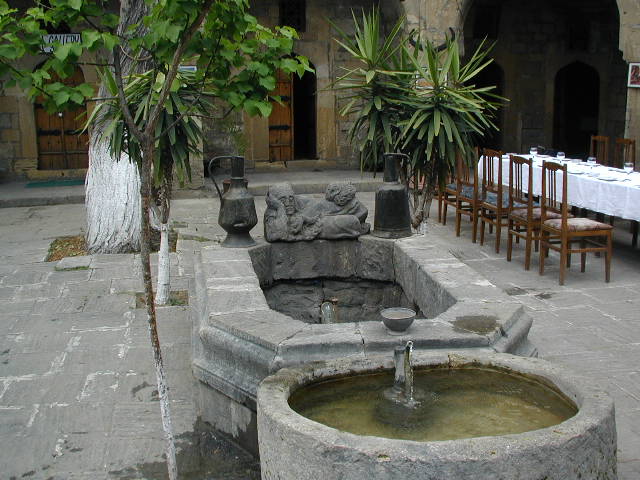
My flight to Baku was via London and I took advantage of that to spend a little time there. The only thing I'll mention publicly about that is that surprisingly few restaurants near Robert's flat are open on Sunday. We ended up at Patio in Shepherd's Bush, which has a generic British menu and a better value Polish prix-fixe menu. For about GBP 12, you can have a quite nice bowl of borscht and excellent mushroom pierogi. You can also get mildly lost wandering around Holland Park on the way back, though that did lead us to discover a most amusing mews. I'd speculate on whether they're terribly House and Garden at number 17, but I doubt many people would get the reference. (It's from a Flanders and Swann song.)
At any rate, British Airways was reasonably efficient, although they're somewhat confused on their geography as London to Baku is not, technically, an intercontinental flight and should, therefore, not depart from Terminal 4. To be fair, the flight goes on from Baku to Bishkek (in Kyrgyzstan) which is in Asia. Passport control was reasonably efficient (i.e. I got through before the bags showed up on the carousel) and there were no real hassles. I was met by my driver/guide, Gurban, and we set off to the Old City Inn. The only specific thing I remember him saying during the trip from the airport was that there are 32 oil companies in Azerbaijan now. It was more memorable when he got pulled over by the police. He said it was just a routine document check, since it was so late at night, but later admitted that he'd been caught going the wrong way down a one way street. I gathered that he paid a bribe, in lieu of getting a ticket.
The hotel proved to be perfectly adequate, albeit a bit noisy. It was well-located just inside the walls of the old city (Icheri Shere) and the first order of sightseeing was a walk around the area. We walked around the city walls, which date from the 12th century and through the main gate. The street led to two caravanserais from the 14th and 15th centuries. Both are now used as restaurants and there's an interesting well in the courtyard of the older one.

The walk soon led to a 17th century market square, where archaeological work has turned up several older tombstones. The domes of a bathhouse are behind the market square and the Maiden's Tower, the most famous site of Baku, is across the street from it.
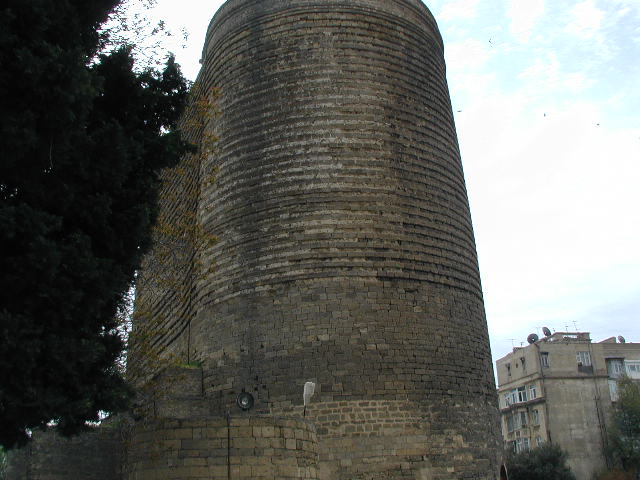
Inside the tower, there's an iron spiral staircase to the second story, then stone steps the rest of the way up. The theory is that, when the tower was used as a fortress in medieval times, people climbed ropes to the second story and pulled the ropes up after them for protection. Gurban's claim was that the tower was originally a tower of silence, where Zoroastrians lifted their dead to the roof to be eaten by vultures. My reading suggests that, while this is a popular belief, it's never been verified. There were no bodies (or vultures) in evidence when we got to the top. There was, however, a good view over Baku.
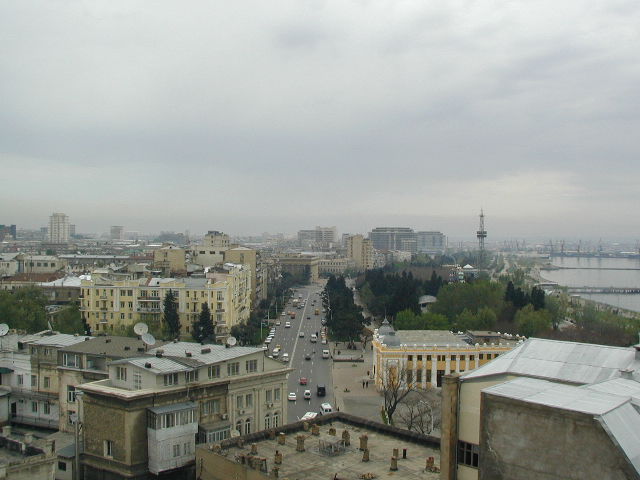
The newer part of Baku is divided into the "white city" and the "black city." The former is the area just outside the old city, filled with oil baron's mansions from when the booming days of the late 19th and early 20th century. Some of those now function as museums, while others have been subdivided into apartments. The "black city" refers to the outlying smoggy industrial areas.
Continuing to wander around the old city, we walked past various mosques, minarets, and embassies. Along the way, we also went into a carpet shop. Unfortunately, all the small carpet pieces (i.e. those I had a chance of actually managing to get home) were somewhat tacky, with the word "Azerbaijan" woven into them. There were some very attractive larger carpets, though.
Eventually we reached the Palace of the Shirvan-Shahs, built by Khalilullah I in the 15th century. The complex was less impressive than I expected, though it has its moments. There are some nicely carved doorways, a mosque, a surprisingly plain mausoleum, and ruins of bathhouses. The most impressive thing to see are the so-called Bayil Stones - a bunch of stone blocks recovered from the ruins of a 13th century castle that was submerged when the Caspian Sea rose. Surprisingly, they include figures of people and animals, not just calligraphy and geometric patterns.
We left the old city and walked past several houses of oil barons before getting in the car and driving to a restaurant. I didn't note the name, but it seemed to be some ways into the "black city." Azeri food is vaguely Middle Eastern. Meals typically begin with salad - a plate of cucumbers and tomatoes and a plate of radishes and herbs. There's also good bread and salty cheese. Then come kebabs, the best of which are sturgeon, eaten with a sauce of sour plums. Lamb - either roasted shanks or ground into a sort of grilled meatloaf - also makes frequent appearances. There's always tea at the end, which Azeris drink with lemon. They don't mix sugar in, but dip a sugar cube into the tea and put it in their mouths to suck the tea through. Azeris also tend to have really bad teeth.
After lunch we drove to the carpet museum. This is in a rather grand Greek revival building. While the collection is huge, including both kilims (flat woven) and pile carpets (knotted), I can't say that it was very informative. They do have looms for the different styles set up, but that isn't very helpful without seeing them actually in use. While the museum is still worthwhile from the aesthetic standpoint, I'll also note that their conservation efforts leave something to be desired. For example, there are no restrictions on touching the carpets. I could practically feel the docents at the Textile Museum in D.C. cringing from nine time zones away.
The final stop on the city tour of Baku was the promenade next to the Caspian Sea. It's a pleasant place to walk, with lots of cafes and amusements. More importantly, there were a lot of people out enjoying it. The only catch is that getting there entails crossing a particularly chaotic street.
Back at the hotel, I took a nap before setting out to walk around Fountain Square (more or less just outside the old city). There's a big pedestrianized area with a lot of shops, as well as the tall ISR Plaza building (which includes the Radisson Hotel) and a huge MacDonald's. I ignored the latter in favor of a local cafe. There was no printed menu, but you went up to a window which displayed what they had - basically salads and kebabs. Food in Azerbaijan is very inexpensive, by the way. My dinners in Baku were not included in the tour arrangements, but I found that I could do quite well for AZM 20,000 or so. (The currency is the Azeri manat, at an exchange rate of about AZM 5000 to the U.S. dollar.)
My arrangements included two day trips from Baku. The first of these was to the north, to Quba and Krasnya Sloboda. The scenery along the way was fairly bleak - shacks that serve as teahouses (mostly run by refugees), an abandoned chemical processing plant, sheep grazing amongst old chemical tanks. The only notable site along the way is Beshbermaq Dag ("Five Finger Mountain"), which fits the image of the sort of mountain you have to climb to find a guru. Gurban said that the associated legend has to do with an old man with five sons. He had a dream that they shouldn't go swimming, but they went anyway and were drowned. He also mentioned some association with the prophet Elias, but that was rather vague. Some people claim to see the face of the old man in the profile of the mountain but it evaded me.
The significance of Krasnya Sloboda is that it's the home of the so-called mountain Jews of Azerbaijan. They are believed to have originally come from Persia. Lonely Planet says this group call themselves "Tat", but Gurban said that "Tat" is an Azeri word meaning "foreigner" and the Jews find it insulting. The community is not large, but is fairly prosperous and has three synagogues, a mikveh (ritual bath), and a day school with about 40 students. There's an interesting cemetery, where the modern fashion in headstones is to have photoengravings of the deceased. We were able to visit two of the synagogues, though I gathered that the caretakers were willing to open them only because I'm Jewish. They're nicely restored, though rather small.

Quba is the Islamic town on the other side of the river from Krasnya Sloboda. It seems that relationships between the communities are good, but largely because they have little to do with one another. Quba has a couple of mosques and a carpet workshop, where it was interesting to see the actual weaving process. We had lunch at a restaurant outside the city and drove through a nice canyon/forest area before the obligatory stop at the carpet store. Overall, I'd say the excursion was only of interest if (like me) you "collect" Jewish communities.
My other day trip from Baku was to Qobustan and the Absheron Peninsula. The former is a petroglyph site and is one of the definite highlights of Azerbaijan. Gurban worked at the museum there for 15 years, so was particularly enthusiastic about the site. That had its downside in (again) a lack of attention to conservation, as he often traced the figures while talking about them. There are several thousand of the rock carvings, the oldest of which may date back as far as the 12th century B.C.E..
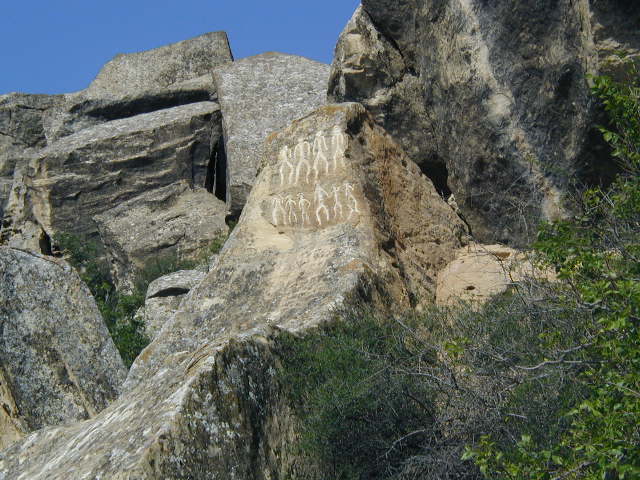
The most characteristic figures are of women with large bosoms and breasts, but no limbs. Men are shown both hunting and dancing. There are several types of animals, as well. The most famous carvings are of reed boats, which the late Thor Heyerdahl claimed may have been built by the ancestors of the Vikings. The site also has a small museum, which is considerably less interesting for the most part. But it does have a replica of a piece of limestone with a Roman graffito from the 1st century C.E., carved by a centurion. The significance of this is that the original, at the foot of the hill, is the easternmost Roman inscription ever found. I should also note that the site has a camera fee (AZM 10,000 or about USD 2), which is worth it if you like petroglyphs.
We returned to Baku for lunch at a Turkish restaurant, stopping along the way to photograph a beach on the Caspian Sea. Not only are there oil derricks in the sea, but there's a factory that makes more oil derricks. It's not exactly my idea of the ideal seaside resort.
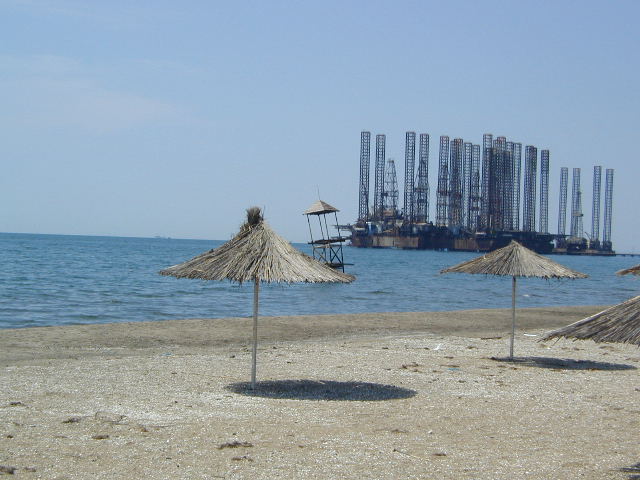
The Absheron Peninsula was far less interesting to me. The roads were particularly bad and none of the sites was really a must. The Ateshgah (Zorastrian fire temple) at Suraxani, is not in use but is, instead, a museum. It has a square tower in the middle of the courtyard with the fire, but the natural gas ran out years ago and flames fueled by local gas mains just don't have the same romance. It also doesn't help to know that the original 6th century temple was destroyed and rebuilt by Indian Parsees in the 18th century. The mannikins arranged in the cells around the courtyard are simply grotesque. In this case, I didn't bother with the camera fee.
Other Absheron Peninsula sites include one fairly modern mosque, a 14th century fortress, and Yamar Dag (Fire Mountain). The latter is a burning hillside and attractive only if you happen to be fond of the smell of oil and are turned on by natural gas vents. The landscape in between these sites is bleak - flat, sprawling, and polluted. I'll also note that during the drive back to Baku, I first noticed advertisements for a local brand of detergent called "Barf." Somehow, it seemed suitable.
Leaving Baku, my next stop was Sheki. Along the way, we stopped first to see a mud volcano. Frankly, this wasn't particularly interesting. Basically natural gas bubbles up, causing sputters of liquid mud. A more interesting stop along the way was near Maraza, where there's the hillside tomb of a holy man. Gurban had a long-winded story about why this man was called "little grandfather," but, as the story focused on a lost sheep, it didn't make a lot of sense to me.
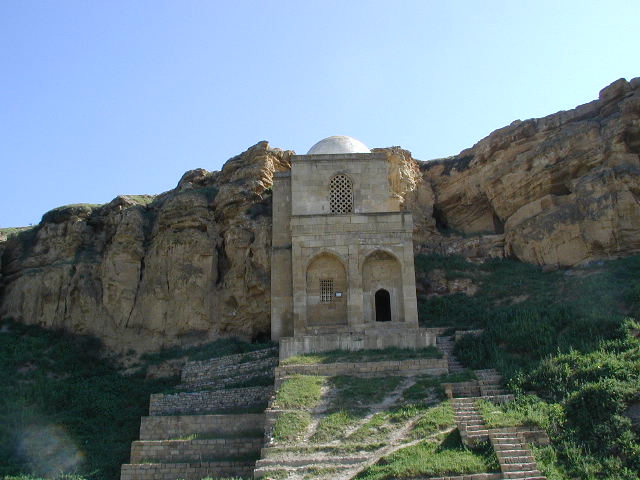
Both of those stops had entailed driving along rough tracks off the main road. Which meant we ended up with a flat tire. Finding a place to get it repaired was easy, but the actual repair seemed more complex than it needed to be, involving at least three people and two cars shuttling back and forth between the shop and some unknown destination. (My guess is a teahouse, but I didn't ask.) The overall delay was probably not more than a half hour and we continued on to Shamaxi. Since this town had been destroyed by earthquakes a few times, there's nothing really old there. We toured a 19th century mosque before driving up to something called Seven Tombs.
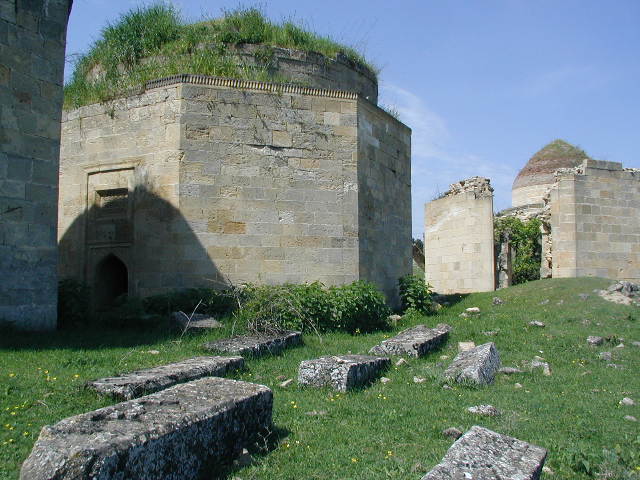
There are really only three of the octagonal domed tombs left intact and they date from the late 18th century. Their significance is as the burial site of the last Shirvan-Shahs. Gurban started to go into one tomb and jumped out hurriedly, saying there was a viper inside. I didn't attempt to verify this.
We stopped for lunch just outside Shamaxi and then continued along the road. At Vandam, a number of roadside vendors were selling fruit. I have a rather unusual digital camera, which has a built-in Polaroid printer. When I gave a young girl a Polaroid of the shot I'd taken of her, this marvelous crone gestured that she should be next. I was delighted, as she was incredibly picturesque.
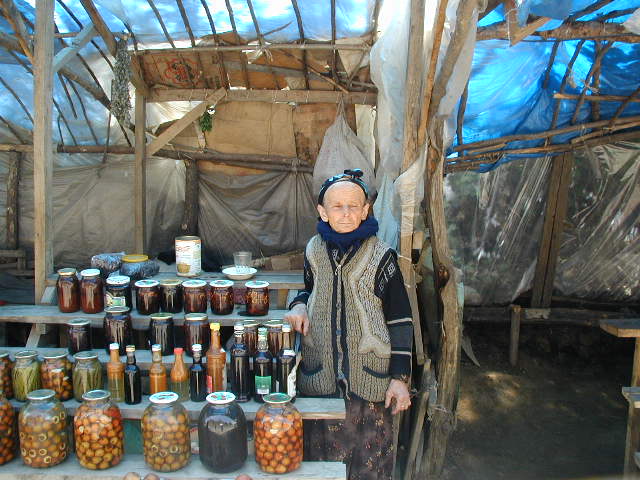
We got to Sheki in the late afternoon and checked into the Karavanseray Hotel. Atmospheric doesn't begin to describe this restored 18th century caravanserai. For example, you enter by stepping through a portal set into a large wooden door.
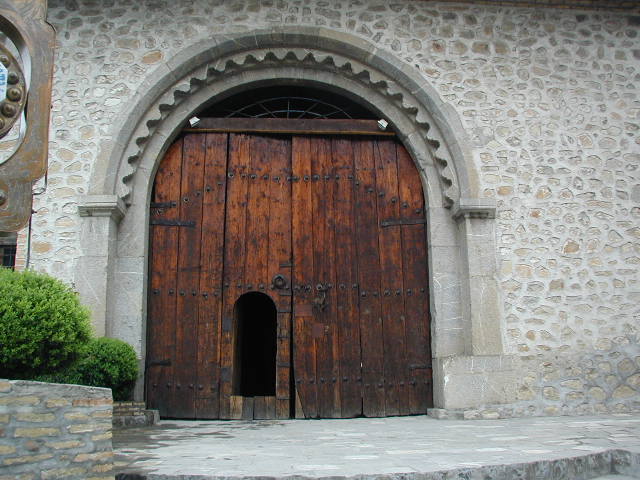
The major tourist attraction of Sheki is the Khan's Palace. The catch is that it's being renovated (until July 2004) so is not actually open to the public. Gurban has a friend there, though, and I was at least able to see the exterior, which is lovely.
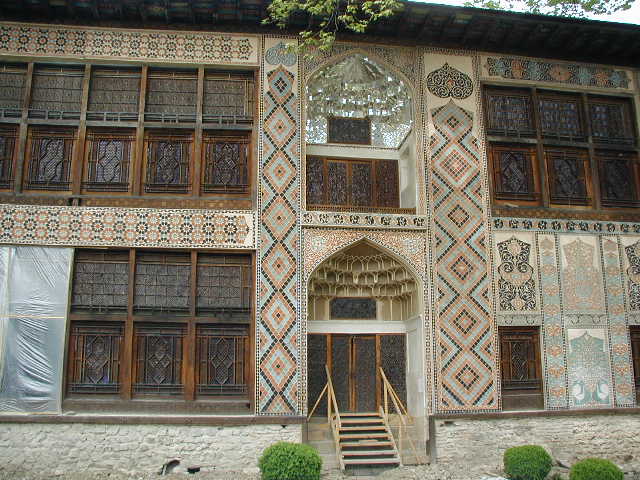
The major feature of the decoration, aside from the elaborate mosaic work, is a type of wood-framed stained glass called shabaka. The frames are slotted so there are no fasteners and it's all very precise and intricate. There's a workshop below the palace where you can see a modern artisan at work. There are also two museums, which focus on local crafts. Sheki used to be known for silk and the embroideries on display were particularly nice. We also visited a sweets shop, where I was forced to taste the local specialty, Sheki halva. This is a stringy fried pastry, with a layer of nuts in the middle. It's soaked in sticky and sickly sweet rosewater scented syrup. The mere memory of it makes my teeth hurt. Dinner at the hotel was considerably better, with piti (a stew of lamb and chickpeas, eaten with bread and sumac) and potato dolma (fried, stuffed croquettes).
Not only is the Karavenseray Hotel atmospheric, the bed in my room was amazingly comfortable. In the morning, after breakfast and a walk around the market in Sheki, we set out on the long drive to Tbilisi. I'll discuss the border crossing in the next section of this travelogue, but I wanted to close with a few general observations about Azerbaijan:
Back to Previous Chapter | Back to Caucasus Index | On to Next Chapter | Xenophilia Home
Copyright 2003 Miriam H. Nadel
last updated 11 June 2003